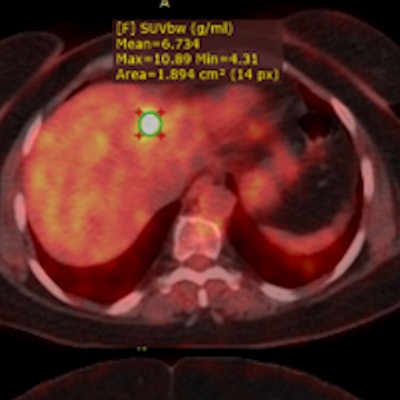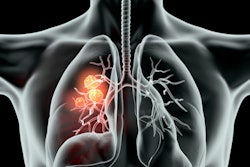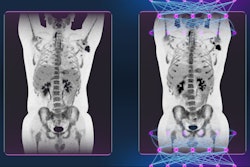
A multinational team of researchers has taken steps to boost radiologists' understanding of how best to use PET/CT and optimize techniques in patients with non-small cell lung cancer (NSCLC).
Dr. Sherif Mohsen Shalaby, a consultant radiologist at the Shrewsbury and Telford Hospital NHS Trust, U.K., and colleagues evaluated the relationship between maximum standardized uptake value (SUVmax) with primary tumor size and its T-stage, as well as patients' demographics in NSCLC.
 F18-FDG PET/CT images of a patient with squamous cell carcinoma. A: Fused axial CT chest shows a primary lung mass with a SUVmax of ~19.3. B: Fused axial CT at the level of the liver shows a metastatic, metabolically active lesion with a SUVmax of ~10.8. C: Fused axial CT at the level of the pelvis shows osseous deposits. D: The coronal maximum intensity projection shows a general view of the body. Figure courtesy of Dr. Sherif Mohsen Shalaby et al, presented at ECR 2022.
F18-FDG PET/CT images of a patient with squamous cell carcinoma. A: Fused axial CT chest shows a primary lung mass with a SUVmax of ~19.3. B: Fused axial CT at the level of the liver shows a metastatic, metabolically active lesion with a SUVmax of ~10.8. C: Fused axial CT at the level of the pelvis shows osseous deposits. D: The coronal maximum intensity projection shows a general view of the body. Figure courtesy of Dr. Sherif Mohsen Shalaby et al, presented at ECR 2022."Although CT scanning has long been the go-to imaging modality to stage lung cancer, it is hindered by many limitations and pitfalls," they noted. "It (CT) may be unable to distinguish a tumor from atelectasis, does not reflect tumoral metabolic activity, and gives no idea about the pathology of the tumor. This can have a negative outcome on a patient's treatment plans and prognosis."
F-18 FDG-PET/CT, on the other hand, depends on the glucose metabolism of tumor cells and has been applied primarily as a staging and restaging tool that can guide subsequent patient care, the authors stated in a poster presentation at ECR 2022.
NSCLC, with different pathological types and sizes, appears to produce different SUVmax values on PET/CT, so a greater understanding of biological mechanisms involved in lung tumor cells provided by combined PET/CT can lead to a better selection of treatment modalities for patients and a better prognosis, they explained.
Study logistics
The group's cross-sectional study included 40 patients, including nine women and 31 men. Ages ranged between 35 and 88, with a mean age of 62.95 years (±10.01 standard deviation). A total of 25 patients (62.5%) had adenocarcinoma, 12 (30%) had squamous cell carcinoma (SCC), and three (7.5%) had large cell carcinoma.
The T staging of the described primary lung masses included nine (22.5%) with T1, 11 (27.5%) with T2, 14 (35%) with T3, and six (15%) with T4 primary mass staging.
The study demonstrated a statistically significant positive correlation between primary tumor size and its metabolic activity expressed by SUVmax of FDG uptake, meaning that the larger the tumor (i.e., measuring greater than or equal to 5 cm), the higher the possibility of FDG metabolic activity, the authors reported.
"Our data showed that there is no significant correlation noted between the age or sex of the patient and the primary lung mass pathology type," they stated. "There was no significant statistical difference between mean max.SUV of males and females. There is also no significant correlation noted between the max.SUV of the tumor and the T-stage of it."
SUVmax is associated with primary lung tumor size, the authors continued. Thus, it can reflect the FDG metabolic activity of the tumor, and the overall SUVmax of patients with NSCLC could be predicted by tumor size value.
Implications of analysis
Chest CT has been "the workhorse for establishment of the precise anatomical and morphological information," but FDG-PET/CT is acquiring an increasing role in the diagnosis and staging of lung cancer.
"The metabolic activity represented by FDG uptake is now considered to be a prognostic factor in patients with lung cancer," they wrote. This means that patients with positive FDG-PET/CT results in treated lung cancer had a significantly worse prognosis than patients with negative results.
The plan now is to publish an extended version of this work in a peer-reviewed journal with more variables correlating SUVmax with pathological types, lymph nodes, and distant metastasis in NSCLC, Shalaby told AuntMinnieEurope.com. They are also submitting a version of it as an e-poster at ECR 2023.
Larger prospective and randomized analyses can potentially reveal more significant relationships, he added.
The coauthors of this research were Dr. Eman Darwish, Dr. Mohamed G. Mansour, and Dr. Amany Rashad, all from Ain Shams University in Cairo, and Dr. Emanuelle Neri from Pisa University in Italy.
You can view the full ECR exhibit on the EPOS section of the European Society of Radiology website.



















